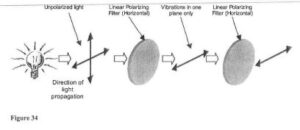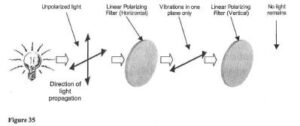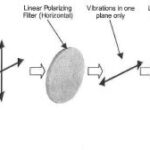How Do Two Polarizers Work Together?
Subject: Physics
Grade Level(s): Grade 8, High School, Grade 3, Grade 7
Topic: Light & Optics
Big Idea(s):
- To explain how two crossed filters can completely block a light beam.
- To describe three applications of linear polarizers.
What you need:
- 2- Polarizing Filters
- Light box and Power Supply
Grouping:
Vocabulary Words:
Time Needed:
Learning Goals / Objectives:
- To observe how two polarizing filters can be used to change the intensity of light.
- To explain these observations using the wave nature of light.
Background
Once light is polarized, it can be passed through a second polarizing filter. Depending on the orientation of the filter, the polarized light may be absorbed or transmitted. Refer to Figure 28. The figure shows a polarizing filter oriented so that it transmits the horizontal component of the vibrations and absorbs the vertical. A second horizontal filter is placed beyond the first filter. This second filter will absorb vertical vibrations and transmit horizontal. Since the light coming from the first filter is already horizontal, the second filter transmits all of the light that hits it and the intensity will not be reduced further. (Practically, polarizing filters are not perfect, and two parallel filters will reduce the light intensity slightly more than a single filter.)
If the second filter is rotated so that it absorbs horizontal vibrations and transmits vertical, the light can be blocked entirely (see Figure 29). The first filter reduces the beam to only horizontal vibrations. The second filter, arranged vertically, absorbs all horizontal vibrations that hit it. No vertical vibrations are hitting the second filter, so no light emerges from the second filter.
This experiment directs students to make the arrangements described above while explaining the theory using a vibrating string as a model. Before beginning this experiment, students should know that light is an electromagnetic transverse wave.
Techniques
The filters should be mounted in the slides so that, when the slide windows are aligned, the polarizing filters are aligned.
If there are enough filters for each student to use two, it can be more effective to have them look through the filters at a light source rather than project light through them.
Anticipatory Set:
How do two polarizing filters work together in different orientations?
Instructions / Activities:
- Plug in the light box and turn on the power supply. Use the end of the light box without the mirrored doors for this activity.
- Place a polarizing filter slide in the inner slot (nearest the light bulb). How does the filter change the amount oflight that is projected from the box
- Place a second filter in the outer slot. Make sure this filter is oriented in the same direction as the first filter (both “windows” horizontal, for instance). How does the second filter change the amount of light?
- Remove the second filter, rotate it 90 degrees, and replace it in the outer slot. How does the rotated filter change the amount of light projected Compare the amount of light with that seen in No.3.
Questions
- Light waves are (transverse/longitudinal).
- Figure 7 uses waves in a string to model light waves. The first part of the wave contains both horizontal and vertical vibrations. The wave then passes through a “polarizer.” This polarizer consists of a vertical hole in a solid plane. The horizontal vibrations are blocked (absorbed) by the plane, but the vertical vibrations are allowed to pass through. Another vertical “polarizer” is placed in the path of the wave. Draw and label the type of wave that will emerge from the second polarizer.
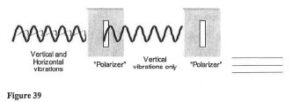
- Figure 31 shows the same situation, but with the second “polarizer” oriented horizontally. Draw and label the type of wave that will emerge from the second polarizer.

- Figure 41 shows the same situation again, but with the second “polarizer” oriented at an angle. Draw and label the type of wave that will emerge from the second polarizer.
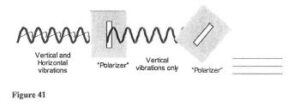
- Recall the last lab, where you observed that polarizers can block glare, depending on their orientation. Figure 32 shows how, when light reflects off a surface, it can become polarized. Horizontal surfaces (such as a road) cause the light to be horizontally polarized. Draw the type of wave that will emerge from each polarizer shown in the figure.
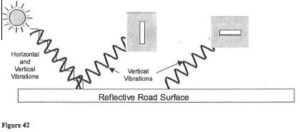
- If you were designing polarized sunglasses, how would you orient the polarizing filters to best reduce glare? Explain your answer.
Assessment:
Teacher’s Discretion
Wrap-up / Closure:
Teacher’s Discretion
Attachments:
These materials are contained in a kit in our Library!
Tags: Grade 3, Grade 7, Grade 8, High School
Categories: Physics

